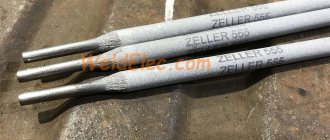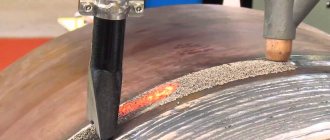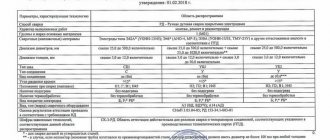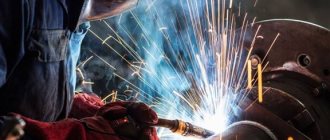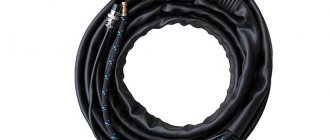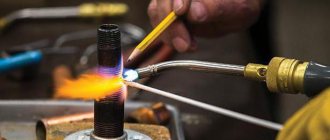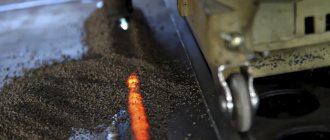Automatic welding is the most popular type of fastening of parts, as it has a large number of different advantages, ranging from the long service life of the seam made to the ease of its implementation. Practice shows that flux is often used to achieve better adhesion.
Scheme of automatic submerged arc welding.
Automatic welding performed using such technologies is the best of its kind, which is why it is very often used in the professional industry. This action is also called submerged arc welding, and it can be attributed to a mechanized method of performing the process.
A special arc for welding melts under the influence of very high temperatures, which is why it burns, directed at the distance between the material and the end of the substance. The welding object itself, which is a wire, is located in the same direction where the welding is facing. For this, a mechanism is used, which, if there is no automatic welding nearby, is replaced by a primitive semi-automatic product. The heated arc melts the specific metal and along with it the flux, which covers the welding area with an elastic film that provides excellent insulation from air.
The essence of the process and options
An electric arc generated between a moving electrode and the workpiece surface generates a large amount of heat.
The metal of the part melts and fills the gap between the parts being connected. When the electrode is removed, the melt solidifies, joining the parts into a single whole. In order to protect the working area from contact with oxygen and nitrogen in the air, as well as the water vapor contained in it, it is surrounded by a layer of flux . This is a special powder, the combustion of which releases protective gases. In addition, the flux contains alloying elements and other additives that improve the quality of the weld.
The powder, the composition of which is described in GOST 16130-72, can be included in the composition of the welding flux-cored wire. Sometimes the entire volume of the welding chamber is filled with inert gas, then the need for powder disappears.
The automatic welding machine monitors the distance between the end of the electrode and the workpiece. There are several kinematic varieties of such machines:
- the head is stationary, the welded pipes rotate in the drive rolls;
- the head moves along a specified path on the manipulator;
- the head is mounted on a self-propelled chassis (tractor), which moves along a given path inside the object being welded.
The automatic machine performs welding work such as:
- “in weight”, without protection for the back side of the seam;
- on a copper substrate along the entire seam line, protecting the back of the connection from drips and sagging;
- on a powder bed that creates a cloud of protective gases;
- on a copper plate moved synchronously with the head.
When performing complex types of joints, techniques such as preliminary welding of the root part and welding of the rear part of the seam are used.
Areas of use
In home workshops, due to the high cost of equipment and materials, automatic welding is rarely used. But in production conditions, where payback is ensured by large volumes of work, automatic machines are used for:
- work with non-ferrous and ferrous metals in various combinations;
- connections of workpieces with a thickness of 1.5 to 200 mm;
- assemblies of especially critical products - housings of nuclear and chemical reactors, pressure vessels and others;
- welding of internal seams of pipelines and containers.
Important! Automatic welding allows the operator to be removed from the welding zone, significantly improving working conditions and production safety.
Can't do without downsides
The method has much fewer disadvantages, some of them can be regarded as technical features:
- What can we say, automatic welding is an expensive method and therefore not accessible to everyone.
- Difficult to determine the correct placement of material for fixation due to the technical characteristics of the process.
- Not a harmless method for the person who performs it.
- Often you need equipment that is only available in industrial enterprises. This feature makes the technique a rare guest in handicraft workshops.
Advantages
Manual and automatic welding use similar welding technologies. The automatic welding method has the following advantages:
- increased productivity, speed is several times higher;
- high stability of seam parameters;
- possibility of deep penetration;
- assembly of vessels and pipes, including large ones;
- a significant reduction in both overall labor intensity and the need for highly qualified welders;
- significant improvement in working conditions and production safety.
Certain advantages come from the use of fluxes, both powdered and supplied from a storage tank through a hose, and those included in the welding wire. These include:
- prevents splashes from the weld pool;
- stabilizes the parameters of the electric arc;
- slows down the cooling of the weld material, improving its properties;
- protects the melt from the effects of oxygen, nitrogen and water vapor contained in the air;
- promotes deoxidation of the weld material and integration of alloying additives into it.
Flux powder is not completely used during welding. Modern tractors clean off and collect the remaining powder along with scale . On older models, this is done manually after the seam has cooled, before applying protective paint coatings.
What are the benefits of submerged arc welding?
Firstly, little flux mixture is wasted - in other words, resources are saved without losing the quality of the seam. This is due to an efficient design with excellent metal adhesion.
In addition, another factor plays a role: this is a neat and very thin coating of the residual weld seam with a protective layer of slag, which protects it from the negative effects of oxides formed from the air. For connecting, for example, pipes, this is the most optimal welding option without any doubt.
Scheme of automatic arc welding.
This technology has many advantages, it’s easy and pleasant to list them:
- Good speed of operation, which gives good performance of the overall process.
- Excellent savings on consumables: the metal of the electrodes is lost by only 2%.
- The technology does not cause the formation of metal splashes, which also leads to savings in base metal.
- The area where the surfaces connect is well protected from the negative effects of air and the environment.
- Minimal oxide formation due to the use of fluxes.
- Excellent fine-scale structure and aesthetics of the weld seam due to an even arc flame throughout the entire welding process.
- Flux plays the role of the main protector from harmful influences, so there is no need for additional protective devices and methods.
- Intensive cooling of the metal after the process leads to the formation of a stable compound.
- This is a fairly simple method to perform and does not require special training.
Varieties
Several types of automatic welding technology are used. On some units, the manipulator moves the head, on others, used for connecting pipes, the head is stationary, and the workpiece rotates. Self-propelled chassis move tractors along a predetermined path inside or outside the parts being connected. In addition to kinematic schemes, methods of creating a protective atmosphere around the welded zone also differ.
In an argon environment
Argon welding is carried out with a non-fusible tungsten electrode in a protective environment of pure argon or its mixture with other inert gases.
The gas mixture is supplied under low pressure to the welding zone through a nozzle built into the head. The method is used both with a fixed head and on tractor systems . Argon welding is especially widespread when joining stainless alloys and some non-ferrous metals.
Cored wire
In this case, a fusible electrode is used. It is a welding wire with a complex cross-section. Under the metal shell there are channels foamed with compressed flux powder. This wire is fed into the welding zone at a constant speed by a special mechanism.
The high cost of manufacturing such wire is compensated by the reduction in the labor intensity of operations for applying powdered flux along the seam line and subsequent cleaning of its residues.
Plasma welding
This technology uses electric arcs, excited between two infusible electrodes in a flow of ionized argon or helium. Due to its elevated temperature, the plasma arc makes it possible to effectively weld workpieces made of high-alloy alloys, including those of great thickness. This method is used to weld the circumferential seams connecting the lids and bottoms of the vessels. If necessary, filler wire is fed into the welding zone by a special mechanism.
Best of its kind
This is an automatic type of welding with a mechanized method of performing the work process. The physical process is simple and straightforward: a special electric arc melts under high temperature.
Automatic welding drawing.
As a result, the combustion flame is directed to the so-called welding object - the wire, which is located in the direction of the seam itself. The arc burns under the cover of a powerful granular blanket - a flux mixture. Due to the high temperature, they begin to melt in the weld pool.
A special elastic film is formed around it, which is an excellent protection for metal and electric arcs from air penetration and the formation of the main enemy of a good weld - an oxide film.
After the process, during the cooling period, the granular flux mixture turns into slag, which covers the new welding seam, and which must be removed in the simplest way - mechanically.
If the work is semi-automatic, the master needs to take a fairly active part in the process: hold and guide the filler wire, which is fed automatically. In addition, you need to monitor the behavior of the electrode: the direction of its movement and the speed of movement and angle of inclination.
If fully automatic welding is used, then the speed and direction of movement of the electrode is performed automatically. This method requires smooth welding surfaces and fillet welds.
The robotic method provides excellent advantages in work: first of all, this concerns the welding joint, which is an order of magnitude stronger than with manual welding methods. The speed of the process is also much faster.
Recently, tandem technology for working with metals has been extremely popular, in which both methods are used, which are carried out parallel to each other in the same plane of the workpiece being welded.
This combination significantly improves the quality of the weld due to the optimal size of the weld pool and the rapid ignition of the electric arc.
Tools to Ensure
An automatic welding machine is a complete technological complex that carries out most of the technological operations to create a welded joint.
However, it should be understood that they cannot always perform most of the preparatory and final operations, such as:
- mechanical cleaning of the seam area;
- degreasing;
- descaling;
- surface preparation and application of protective coatings.
In most cases, this work is carried out, as before, manually. They require angle grinders, wire brushes, solvent sprayers and rags. Only the most modern tractor models are capable of pre-cleaning the seam area.
An automatic electric arc welding machine involves software control of both welding modes and the supply of the workpiece (or the movement of the tractor along it). Therefore, an important component of modern machines is the processor unit containing control programs . The program is generated in a post-processor based on data from a three-dimensional model of the product loaded from a parametric modeling application.
The creation, testing and debugging of such a program requires the working time of highly qualified specialists, therefore the economic efficiency of automatic welding is achieved in two cases:
- production of a series of products;
- production of unique, but very important structures (aerospace industry, nuclear energy, etc.).
It is more efficient to make a single product or a small series of ordinary parts using semi-automatic welding. In this case, the welder moves the head along the weld line manually, and the modes, wire supply and shielding gas are controlled by mechanisms.
A. Somushenkov, ch. technologist at the Ust-Malonsky Metal Products Plant: “The use of automatic welding machines allowed the enterprise to achieve the specified quality of welds and save on attracting highly qualified welders. It is especially beneficial to use the technology on medium and large batches of parts.”
Device design
The main design elements of an automatic welding machine, common to all varieties, are as follows:
- power source: powerful inverter unit, which allows you to receive welding current of the required voltage, strength and polarity;
- welding head, fixed on the machine or on a manipulator, either fixed infusible electrodes or a mechanism for feeding welding (filler) wire, as well as nozzles for supplying shielding gas are attached to it;
- workpiece feed mechanism for stationary machines;
- self-propelled chassis for tractors;
- storage location for gas supplies and wiring;
- control system containing a program for controlling welding modes and movement.
Depending on the technology used and the type of workpieces being welded, automatic machines can be equipped with additional equipment:
- inertial positioning system for orientation inside extended structures;
- CCTV cameras for visual control by the operator of the welding progress;
- systems for preparing the joint area for welding and seam cleaning mechanisms.
Based on the requirements of a specific technology, significant changes can be made to the design of the device, including changing the length and degrees of freedom of the manipulators, equipping the chassis with magnetic fasteners, specific settings of welding modes, and others.
Some of them can be performed at the production site by service departments. Major changes to the design require intervention from the manufacturer.
Necessary equipment
The connection of parts must occur with stationary workpieces. For this purpose, mobile type heads are sometimes used. The industry produces both special units for automatic welding and semi-automatic machines that operate under a layer of flux.
Wire is used with a diameter of up to 3 mm. It is supplied automatically.
Some models of devices are equipped with a mechanism for collecting flux that does not melt. There is a device for monitoring seam parameters. Devices equipped with a laser independently monitor the position of the welding electrode. The screen is installed at a distance of up to 20 m from the self-propelled tractor.
This is interesting: Hot metal stamping: the essence and advantages of the technology
